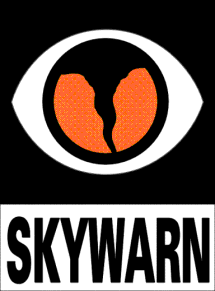
National Weather Service SKYWARN®
The effects of severe weather are felt every year by many Americans. To obtain critical weather information, NOAA's National Weather Service (NWS), part of the U.S. Department of Commerce, established SKYWARN® with partner organizations. SKYWARN® is a volunteer program with between 350,000 and 400,000 trained severe weather spotters. These volunteers help keep their local communities safe by providing timely and accurate reports of severe weather to the National Weather Service.
Although SKYWARN® spotters provide essential information for all types of weather hazards, the main responsibility of a SKYWARN® spotter is to identify and describe severe local storms. In the average year, 10,000 severe thunderstorms, 5,000 floods and more than 1,000 tornadoes occur across the United States. These events threatened lives and property.
Since the program started in the 1970s, the information provided by SKYWARN® spotters, coupled with Doppler radar technology, improved satellite and other data, has enabled NWS to issue more timely and accurate warnings for tornadoes, severe thunderstorms and flash floods.
SKYWARN® storm spotters are part of the ranks of citizens who form the Nation's first line of defense against severe weather. There can be no finer reward than to know that their efforts have given communities the precious gift of time--seconds and minutes that can help save lives.
Who is Eligible?
NWS encourages anyone with an interest in public service and access to communication, such HAM radio, to join the SKYWARN® program. Volunteers include police and fire personnel, dispatchers, EMS workers, public utility workers and other concerned private citizens. Individuals affiliated with hospitals, schools, churches, nursing homes or who have a responsibility for protecting others are also encouraged to become a spotter.
How Can I Get Involved?
NWS has 122 local Weather Forecast Offices, each with a Warning Coordination Meteorologist, who is responsible for administering the SKYWARN® program in their local area. Find a class in your area: Training is free and typically last about 2 hours. You'll learn:
-
Basics of thunderstorm development
-
Fundamentals of storm structure
-
Identifying potential severe weather features
-
Information to report
-
How to report information
-
Basic severe weather safety

Welcome to the Pittsburgh, Pennsylvania National Weather Service SKYWARN™ program. SKYWARN™ is a group of trained severe weather spotters that report directly to the National Weather Service.
Year after year, reports from SKYWARN™ observers have assisted the NWS in issuing timely warnings based on REAL-TIME reports throughout our 36 County Warning Area covering parts of PA, WV, OH, and MD. The NWS's primary mission is to issue warnings to protect life and property.
The ground truth reports from SKYWARN™ spotters are a vital link in using advanced radar data and meteorological skills to carry out our mission. Their observations also provide us with information in compiling documentation of severe weather events and verification of warnings. These reports become part of the Untited States Storm Data publication, which is used by researchers and also provides climatological data on a wide variety of unusual weather phenomenom, including statistics on death, injuries, and property and crop damage.
Over half of our 1600 + spotters are also licensed amateur radio operators (a.k.a hams). The hams throughout many of our counties meet and organize their spotter efforts on one radio frequency (network or nets), when severe weather threatens. Amateur Radio Emergency Services (ARES) provides communication support for the SKYWARN™ program.
SKYWARN™ also publishes a newsletter to its spotters. The latest news about the SKYWARN™ program can always be found here.
Interested in becoming a SKYWARN™ spotter? Check out our list of upcoming training sessions.
HAM Radio Skywarn™ Net Frequencies:
Fayette 145.045 - 131.8 147.17 pl 131.8
Greene 145.23 pl 156.7 147.30 pl 156.7
Westmoreland 147.18 pl 131.8 145.15 pl 131.8